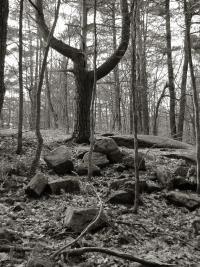|

photo - mw
_______________________
Fifty-one contemporary poets from Australia
edited by Pam Brown
jacket2
The Anaglyph
John Tranter
Hasn’t the charisma leaked away from the café crowd, and that other
Authority, the Salon des Refusés? I have forgotten much of
That old sack of enthusiasms and snake-oil recipes, the way
You have forgotten your own childhood, since
You woke up just in time to watch the adults disappear
From the world they had bequeathed us. It seems the scenery all around
Is hilly and unfarmable. Being brilliant has been reckoned
Into a procedure by some old guy, with a motto that is
More fitness, less flab. I hanker to go back to the land.
This means ruin to the culture-watchers. But the basic
Principle of my ambition is to be one excessively distracted
Entity at the mercy of the lurid, blurred and half-perceived
Motions of the Martians at the Halloween Hop. Fake? They sure are.
Summer is called Humidor here, the month of damp draughts.
...(more)
Australian Poets at PennSound
_______________________
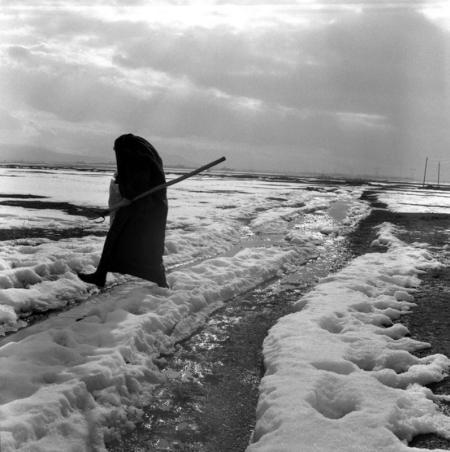
The line of life
Rena Effendi
presented at Poemas del rio Wang
Pipe Dreams:
A chronicle of lives along the pipeline
Rena Effendi
_______________________
I, Kafka and Deleuze-Guattari
Ene Mihkelson
1.
Look how the machine of living works
what desires fill it The Trinity
moulders among old junk God blows his
nose on the silver wholeheavens
If there was once love now the body is
so pierced by possibilities that shamelessly I
lie into piety
The dream is always real and we crave
the same eyes without asking about color
Verse has rhythm and meter and repetitions
have their own circular motivations
Let me be a machine God
trains the animal in me and the schizoid freedom
2.
I am one but the perspective is
everywhere and always so different that
I disappear into intersecting shafts of light
and am the same everywhere if whoever
in whatever place cares to notice me
How much nonexistence surrounds all
of us and even that weighed by reason
What else could absence be if not
death and what else is memory
if not renamed life
(From the monthly Vikerkaar, 12/1998)
_______________________

The Fog, The Woods, The Human
Bastian Kalous
via (OvO)
_______________________
Something on Paper Issue 1
an annual online poetics journal of scholarly utterance and conversation, archiving the critical work of the Jack Kerouac School as well as engaging with a broader community of writers, critics, and pedagogues. Each issue hosts cutting-edge literary/multimedia discourse and performs the liminal space between critical and creative texts. Our aim is to document the praxis of poetic exchange.
Wild Captioning
Lyn Hejinian
(....)
... this essay rests, however precariously, on a triad of personal investments: in the maintenance of social systems to support the flourishing of all elements that contribute to the public good; in the attempt to understand the immediate political, economic, and social forces in play in the milieu in which I live and work; and in attempts to explore the possibilities and imperatives of aesthetic creative practice.
I hope, in what follows, to evoke a notion of allegorical activism, or of activist allegorizing, as an artistic and as a political practice, not in the service of utopian planning (though I am always ready to be enthusiastic about that) but in the service of activating some of the creative potential in everyday life. My premise—which may be mere wishful thinking—is that divisions between creative work, political activism, and everyday life can be bridged; that all three can be configured differently but together under the rubric of aesthetic practice; and that the function of a creative-political-quotidian aesthetic practice is allegorical, at least insofar as it is achieved through imaginative captioning that may serve to decompress both space and time.
...(more)
_______________________

photo - mw

photo - mw
_______________________
First 15 years of Symposium Now Available Open Access
the official journal of the Canadian Society for Continental Philosophy
Volume 15 Issue 2: Special Issue On Jacques Rancière
A Poetics Of Sharing:
Political Economy In A Prose Poem By Baudelaire
Kevin Newmark
Abstract
The rehabilitation of aesthetics that is undertaken by Jacques Rancière for a thinking of both art and politics is as stylistically refreshing as it is philosophically appealing. The combination of vast scholarship and lively polemic that underpins all his analyses also lends his celebration of democracy, equality and humanity a persuasiveness that is difficult to resist. This paper examines how Rancière’s understanding of “the aesthetics of politics” differs from that of Walter Benjamin, especially in terms of Benjamin’s elaboration of the change sustained by “experience” in modernity. It considers how reading a prose poem by Baudelaire throws into relief what is at stake in this difference.
_______________________

"Ponte-Campovasto"
1914
Peder Mørk Mønsted
b. December 10, 1859
_______________________
Banish Air from Air -
Divide Light if you dare -
They'll meet
While Cubes in a Drop
Or Pellets of Shape
Fit -
Films cannot annul
Odors return whole
Force Flame
And with a Blonde push
Over your impotence
Flits Steam.
Emily Dickinson
b. December 10, 1830
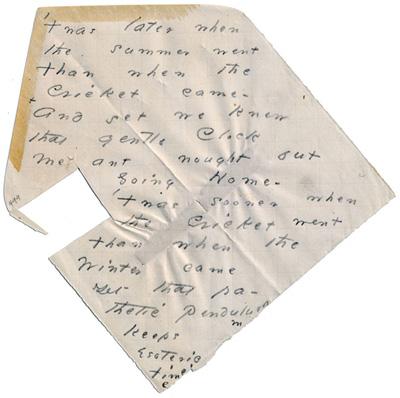
The Gorgeous Nothings by Emily Dickinson
Reviewed By Camden Avery
(....)
This temporal play in space is the only way to read Dickinson: there’s a special correspondence between her language and her tactile form. During her life, Dickinson assembled her poems herself, in her own manner. She bound them in packets that she famously hand-stitched with thread: stitches and characteristic dashes echo across her work, connecting, dividing, letting in light. We knew this already, but as we see in The Gorgeous Nothings there was much more to it than that.
“These envelopes,” write Bervin in the introduction, “have been opened well beyond the point needed to merely extract a letter. … Dickinson is [forcefully] manipulating the form of the page itself.” Dickinson’s radical manipulation of space extends to the form of her text: she leaves enormous blank spaces, divides space into columns, writes in several directions at once, writes upside down, marks the page with crosses and borders and gestural lines. She has a habit of choosing her words on the page, in time: alternates aren’t scratched out but stand side by side, often causing a scan of the poem to splinter as it moves across the page; one poem becomes two, five, nine separate poems. Some pieces are written only on the flap of an envelope; others are written across two or three leaves glued to form the seam of an envelope. Others still are written in unhinged fragments across envelopes painstakingly opened and spread flat like hands, or the wings of birds.
...(more)
Unsettling Emily Dickinson
The co-editor of The Gorgeous Nothings (Marta Werner) talks about the challenges of editing the iconic poet.
(....)
After all the manuscripts have been carried away from Dickinson’s room, questions whirl in their place and do not settle.
All the editions of Dickinson’s writings are also attempts to “settle” the work. And it’s for that reason that I work on unediting her writings. It’s a way of unsettling them—though not, of course, the way Dickinson may have unsettled them.
The poems and other writings in The Gorgeous Nothings were all in print by 1958. A careful reader can find them in Johnson’s Poems (1955) and in his Letters (1958). But you’d be surprised to know how many people think that the writings in The Gorgeous Nothings are new discoveries. Even people who know Dickinson well can’t recall seeing them before. And of course that’s because they haven’t seen them—they’ve only read them. Somehow, for reasons I don’t wholly understand, reading in manuscript is fundamentally different from reading in print. For some people—myself among them—it’s a kind of further seeing. It’s my hope—and Jen Bervin’s too, I’m sure—that The Gorgeous Nothings functions like a kind of light-table for these writings.
...(more)
_______________________
The madcap pencil strokes, torn edges, and higgledy-piggledy line breaks are the work of a quick-thinking, passionate woman. But the carefully crossed through and reworked prose are the mark of a poet bent on perfection. The harmony between the content and use of space, most of all, reveals Dickinson’s self-awareness and inherent knack for poetic construction. One small triangle of paper reads, with the words forming an upside down pyramid, “In this short life/ that only lasts an hour/ merely/ How much — how/ little — is/ within our/ power.” That self-important word, “power,” is smirkingly wedged between a smudge and a tear. On another little rectangle, Dickinson merely wrote, “A Mir/ acle for/ all.” And on an envelope whose face bears a carefully calligraphed “Miss Emily Dickinson” and whose rear is covered with a more elaborate poem, Dickinson has gently pencilled, “To light, and/ then return —”.
Hillary Kelly
_______________________
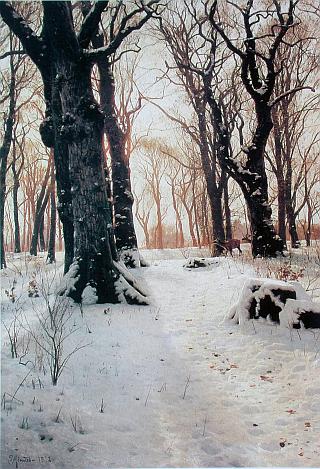
Peder Mørk Mønsted
_______________________
Traveling furiously toward you
John Ashbery and the arts
jacket2
(....)
Poetry and painting are set in an interlinked relation of the arts, with music, dance, movies, theater, and literature, all feeding new aesthetic questions as they come into being.
With these overlapping affinities in mind, we went about assembling “John Ashbery and the arts” wanting to explore how artists across genres respond creatively to Ashbery’s poetry. Our most exciting revelation was how much everyone here fashioned work by reading himself or herself into Ashbery’s. That is to say, contributors created their pieces through reading their own sensibilities into Ashbery’s, and not the other way around.
The distinction is as subtle as it is generative. We discovered that the house of Ashbery is generous and catalytic: were many of the artworks published here to be gathered under other circumstances, they might not seem to have much in common. But instead, they roam through dance, theatre, poetry, music, translation, and essay, in styles so divergent, they push at the outer description of the word while still tracing correspondent lines to Ashbery’s work.
One of Ashbery’s particular strengths is how he accommodates so very much. His dexterity with tone allows for compositions into which he can place almost anything — movie titles, comets, skaters, abstract painting, and comics — and make them work. More precisely, perhaps, not so much “work,” as mystify, surprise, open language in ways that would be nearly impossible to anticipate.
Quiet Moon
Harry Mathews
(incorporating a poem by John Ashbery)
No comfort in the dead wind
And its loud philosophizing;
The glumly repeated eyelets
Tease me with hushed reproach,
And snores of my friends and lovers
Tell me “last night was just that.”
Ah, solitary night! Except for my goofball
Baby next to me — no snoring there, not yet,
But that won’t matter amid the irregular
Screams tomorrow morning. It’s weird how upsetting
Extreme calm can be; it won’t let you think:
The rumpus of natural silence, the frenzy
Of immobility, not like last night
When the woods burbled, and fire crackled
That is now still as a still photograph. ...(more)
_______________________

photo - mw
_______________________
Ene Mihkelson
(From Selle talve laused, 1978)
(....)
From year to year perhaps understanding better what keeps you locked
in yourself
that can really be simple and one
but carefully covered transparent only when keenly observed
palpable at its core when misfortune uncoils
life turns itself around and
starts to flow backward here is the beginning
that the end holds in its hands like a result
...(more)
Ene Mihkelson. Naming the things of the world
Janika Kronberg _______________________
Poetry by Ene Mihkelson
Estonian Literary Magazine
I am concrete like a comb's tooth that kills
lice I am merciful and I take everything
together to a stove where fire glows
One needs to reserve firewood like death
In the stable I assure a horse it will not be taken
to a fox ranch I feed it hay from my hand
It must be winter I infer it from rosy feet as
I run glowing through snow to the house
Where is eternity Where love While it is necessary
to kill lice and horses every last one
_______________________
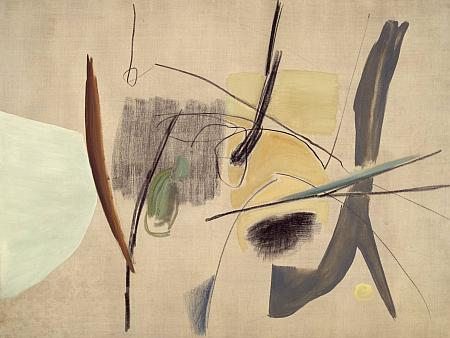
T1937-33 1937
Hans Hartung
d. December 7, 1989
_______________________
I never hear the word “Escape”
Without a quicker blood,
A sudden expectation –
A flying attitude!
I never hear of prisons broad
By soldiers battered down,
But I tug childish at my bars
Only to fail again!
Emily Dickinson
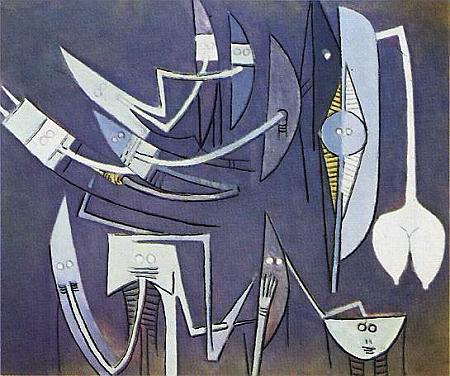
The Witnesses
1968
Wifredo Lam
b. December 8, 1902
_______________________
Ivan Alechine: Muxa Uxi, a Poem from the Huichol Sierra
with Notes by the Author
Translation from French by Wendy Parramore
presented by Jerome Rothenberg
(....)
I followed the path
I wrote in the snow
I drew in the sand
against and to the flow
with the lines and with the walls of earth
with bucketfuls of whitewash splashed
howling mute slap-dash
from my sponge – suitcase
from my hand to my eye
from Pierre to Christian
from Jean to Charles
and from Asger to Scylla
I saw
I see the path
winding its way
through the oaks and pines
I saw it
I see it begin at the barbershop in Dublin
It’s there
in front of my eyes
as I sit on my chair
leaning my back against the dried mud wall
unmoving I keep on walking
my foot on the high plain
the least movement a word
...(more)
_______________________

Dunes In Winter
1972
Ian Hornak
d. December 9, 2002
_______________________
Arguments from a Winter’s Walk
Thomas Bernhard
translated by Adam Siegel
(....)
Out here are peculiar valleys, said the doctor, and in these valleys are castles … one goes into them and there is nothing more in the world to seek out, the world whence one came … doors open, and behind them, enthroned, sit people in expensive clothes, as though drawn from nonexistent portraits, unheeding … one enters … one is addressed, seemingly without ever hearing a voice or language … having always been untutored in this art … I know nothing of words … nothing of answers … one doesn’t speak, one just listens—everything has a serviceable name, a label, none of it applied in error, you should know … they say simple things that float above you like a cloudless blue sky … nothing fantastic though it all stems from fantasy … nature—the greatest simplicity, opulence, amiability, nary a trace of sin … not even a hint of discord … a perpetual honeymoon, you should know, just cool reason and the innateness of concepts … all our days and all our nights—comely faces for now and for always … sleeping and waking … the air wrought so clear … my God—how apt! … the slow effect of ideas, feelings, climaxes, feigned amazement … laws that lack the punitive element have a certain validity, mind and temperament united in human nature—logic set to music … old age capable of beauty, youth rising like foothills … in the afternoon the shadows fall … truth lies in the bed of the river, they say, the inscrutable as realization … this is, said the doctor, more like a revelation from a dream, but truer than most means of contemplation …
...(more)
_______________________
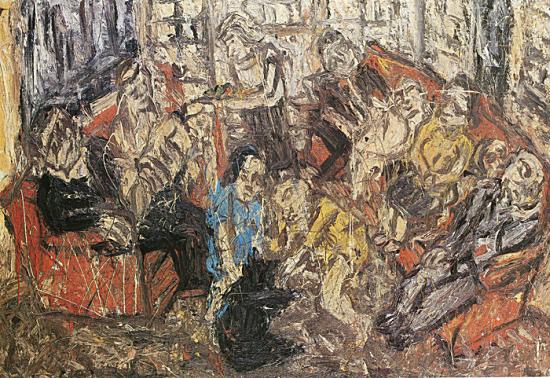
Family Party
1983
Leon Kossoff
b. Dec. 7, 1926
_______________________
On Violence
Edition no. 1
... contents to include: “The Dignity of Non-Violence” by Todd May; “The Remains of the Day” by Brian Massumi; “Violence Against Violence” by Saul Newman; “No Magic Bullets” by Nancy Scheper-Hughes; “Theater of Mayhem” by John Steppling; “Unjust Justice” by Lewis Gordon; “Addicted to Violence” by Henry A. Giroux; “Violence, Truth & Courage” by Michael Dillon”; “Combat & Combat” by Cynthia Enloe; & “An Open Letter to Immanuel Kant” by Julian Reid.
Inaugural Statement
Brad Evans
(....)
The concept of violence is not taken lightly here. Violence remains poorly understood if it is accounted for simply in terms of how and what it violates, the scale of its destructiveness, or any other element of its annihilative power. Intellectual violence is no exception as its qualities point to a deadly and destructive conceptual terrain. Like all violence there are two sides to this relation. There is the annihilative power of nihilistic thought that seeks, through strategies of domination and practices of terminal exclusion, to close down the political as a site for differences. Such violence often appeals to the authority of a peaceful settlement, though it does so in a way that imposes a distinct moral image of thought which already maps out what is reasonable to think, speak, and act. Since the means and ends are already set out in advance, the discursive frame is never brought into critical question. And there is an affirmative counter that directly challenges authoritarian violence. Such affirmation refuses to accept the parameters of the rehearsed orthodoxy. It brings into question that which is not ordinarily questioned in any given state of political affairs. Foregrounding the life of the subject as key to understanding political deliberation, it eschews intellectual dogmatism with a commitment to the open possibilities in thought.
(....)
Perhaps the most difficult task faced today is to avoid the false promises of violence and demand a politics that is dignified and open to the possibility of non-violent ways of living. This demands new ways of thinking about and interrogating violence such that the value of critical thought becomes central to any mediation on global citizenry. As we all increasingly find ourselves in a position where the radical and the fundamental have been merged to denial of anything that may challenge the violent effects of contemporary regimes of control, the inevitable assault upon the university and all intellectual spheres continues with unrelenting force. This is not incidental to the violence of our times. It is one of its more pernicious manifestations. Our response, as the authors in this inaugural edition make clear, must be to counter this violence with a commitment to the value of criticality and public education. Hopefully “On Violence” will provide a modest counter to those who insist that violence may be reasoned for the greater good. Without this hope that the world may be transformed non-violently for the better, the fight for dignity is already lost.
a project of Histories of Violence
_______________________

Patience (After Sebald)
a walk through The Rings of Saturn
dir. Grant Gee, 83 min, 2012
a multi-layered film essay on landscape, art, history, life and loss - an exploration of the work and influence of WG Sebald, told via a long walk through coastal East Anglia tracking his most famous book The Rings Of Saturn.
Monoskop a wiki for art, culture and media technology.
via Synthetic_zero
_______________________
"Drive your cart and your plough over the bones of the dead"
John Holloway
Spit on history. History is the history of oppression told by the oppressors, a history from which oppression conveniently disappears, a history of Heroes, of Great Men.
Spit on history. History, even our history, is a history in which the struggle against oppression is invaded by the categories of the oppressors, so that it too becomes the history of Heroes, of Great Men, of Marx, Engels, Lenin, Trotsky, Stalin, Mao.
(....)
Spit on history because "an ideology of history has one purpose only: to prevent people from making history".
(....)
We live in a world of Monsters of our own creation which have turned against us. They stand there, apparently independent of us, oppressing us: Commodity, Money, Capital, State and so on. They were there yesterday, they were there a hundred years ago, two hundred years ago. It seems certain that they will be there tomorrow. They are oppressing us, dehumanising us, killing us. How can we free ourselves, how can we get rid of them? They have been there for so long, their existence seems everlasting. How can we possibly escape?
"Wake up," says Papa Marx, "it"s just a nightmare. These Monsters are an illusion." We wake up and the Monsters are gone, we see that they were not everlasting, their duration is dissolved.
But no. It is not as simple as that. Maybe our vision of Marx was just a dream, because when we open our eyes the Monsters are still there, and more aggressive than ever, attacking Iraq, closing factories, reforming universities in their own image, subordinating every aspect of our lives to their domination, turning us into little monsters ourselves, so that we run around worshipping Commodity, Money, Capital and State.
The nightmare continues. Yet Marx was right, it is a nightmare, and the Monsters are illusions. But they are not mere illusions, they are real illusions. They are what Marx calls "fetishes". But what is a real illusion? On that hangs the meaning of revolution.
...(more)
Change the World without taking Power: the Meaning of Revolution Today John Holloway full text
via Forgottenness
_______________________
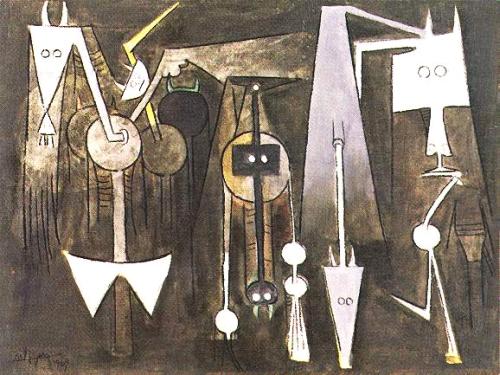
The Shadows of Days
Wifredo Lam
1970

Night in a Small Village
1984
Yu Chengyou
multi-block woodcut, printed with oil-based ink
The Revolving Moon: 25 Prints from China
50 Watts
_______________________
Last words
As we mourn the poet, do we not mourn the loss of what he had in his keeping: a way of living that served us for aeons?
by Sven Birkerts
aeon
(....)
I had not thought until recently that these two occasions — my visiting Peter’s campus to talk about the transformations of the reading culture, and his later notifying me of Seamus’s death — belonged together in an essay, but I see now that they do. Not easily or obviously, not in tongue-and-groove fashion, but more broadly, thematically, with all the allowances of essayistic elasticity. If I pose for myself the two big questions that I am forever asking, that were, in effect, the basis of my talk — namely, what is the transformation that is taking place? And what is it that I fear the loss of? — then the connection starts to come clear.
It is dangerous, I know, to have a person stand for something, be ‘representative’ in the sense that the poet Ralph Waldo Emerson had it in 1850. That one individual could in any way ‘embody’ the spirit of a historical period seems archaic, as does the notion that a period could have a spirit. Our cultural mantra is plurality, complex polyvalence, and the intensifying deluge of information ensures more of the same. Character itself is a contested concept.
Yet when Heaney died in August, in the days and weeks that followed, there was a sense, throughout the literary world, but in the larger culture as well, that a singular and — I will risk the word — representative greatness had been taken from our midst. ...
(....)
Not only does our digital living condition us profoundly, and by the stealthiest increments — so that with every new upgrade, every app, we are not only further empowered, but also more deeply reliant — but it also creates in us an estrangement, a sense of void. We gain in so many ways, pulling the info-world around us like a wire-woven cowl, creating planes of lateral linkage, giving and receiving messages — most of them tokens of ersatz connection — through a switchboard of disseminated impulses. We take the old limited one-self and refract it in every direction, and all around us people are doing the same, confirming us in our impulse. How easy it is to move in that direction — enabled flow — and how hard to move even slightly back the other way. If it’s so easy, it must be right.
But those gains are not without their sacrifices — though, as I observed, it gets harder and harder to see what those might be. Still, we do mark them, sometimes obliquely, by proxy. With, for example, the force of our sadness for a great man who has died, a poet with the rarest access to how things were, to the time and space of the old dispensation. T S Eliot’s ‘still point of the turning world’. We mourn the poet, but are we not also mourning the loss of what he had in his keeping? A language that mapped a way of living that served us for aeons, that we are now exchanging for other ways. We don’t regret our progress, not for the most part. But there is a tug. And in contemplating a poet such as Heaney, we understand what it is that still exerts that pull.
...(more)
_______________________

Alfred Eisenstaedt
b. December 6, 1898
_______________________
Shane Rhodes On Beauty
lemon hound
(....)
All of this is to say that it is easy to become enamored with the production of beautiful language and the ceremony of its performance. Governments and large corporations are particularly good at this – we call it propaganda but I think that makes it sound too specialized as it is a strategy used in many subtle ways that might not meet that jingoist threshold. In art, I think it is imperative to understand how our ability to make beautiful language can also divert attention away from the ugliness in the world around us. Throughout history and in the present, we can see art used again and again as diversionary tactic. I’m not saying that every poem has to be a realist examination of social ills, but good art, complex art, seems knowledgeable about how it is consumed and about the society in which it takes place and that this must, in some way, be part of the artistic production and product itself.
(....)
So often we are led on by ideas of beauty and deterred or stopped by ideas of ugliness and disgust – but it is important to think of how these terms can be politically motivated and used. Colonization has very real psychological manifestations in any settler society; one of these manifestations is an unwillingness in the settler to look realistically at the injustices of our histories and current actions in the name of settlement. In Canada, who wants to read the treaties? Who wants to read the Indian Act? Who wants to look at such blatant racism? All of these texts are ugly; they are ugly because they rub against the beautiful myths we have created of our just and peaceful society.
...(more)
Shane Rhodes, X: Poems & Anti-Poems reviewed by rob mclennan
Shane Rhodes - X: Poems & Anti-Poems (an interview)
Toronto Quarterly
You Are Here
Shane Rhodes
Though not endorsed by the treaty commissioner, I would like to
acknowledge this book was written in the said country
While this book was written, contested territory was tested
I would like to acknowledge the Secwepemc, the Cree and the
Algonquin nations, upon whose territories this book was written
The land was “shovel ready”
I would like to acknowledge I did not ask for permission, that I
felt too uncomfortable to ask and didn’t know how to, that I don’t
know if asking is the answer because I barely know the questions
I would, however, like my acknowledgement to be acknowledged
Warning: this book is not about faraway lands, Greek and Roman
philosophers, Japanese haiku masters, and Elizabethan poets will
not be discussed
This book is about desire
the desire to look elsewhere
This book is about where I live, a place still settling, still making
the land—law by law, arrest by arrest, jail by jail—its own
snow blown
As stipulated in subparagraph 12(1)(a)(iv), paragraph 12(1)(b) or
subsection 12(2) or under subparagraph 12(1)(a)(iii) pursuant to
an order made under subsection 109(2), a dispute cannot be made
under this section of my book
Warning: this book of verse demands more of verse, this book
demands perversity
This book uses words as heard in annual reports and business prospectus,
the smooth cadence of policy platforms and parliamentary
committees, the shouts of protesters and riot police
...(more)
_______________________
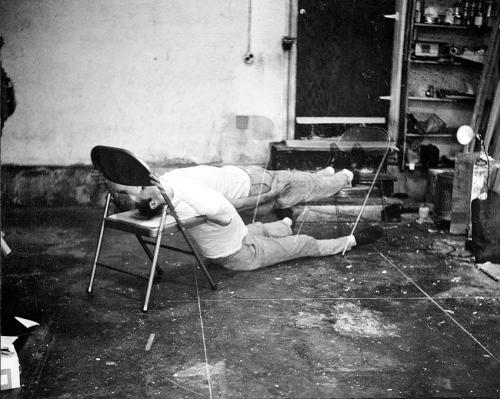
Failing to Levitate in the Studio
Bruce Nauman
1966
_______________________
The Way We Live Now: Surveillance
The Occupied Times
_______________________
The Deep State: An Emerging Concept in Comparative Politics
Patrick H. O'Neil
Abstract:
Over the the past two decades there has emerged a new term in the discussion of authoritarian and illiberal regimes, one known as the deep state. In spite of its increasing use, the utility of this concept is limited by its lack of clarity, often appearing to mean little more than tenacious military rule. This paper is an attempt to delineate the concept of the deep state and assess its value in understanding certain aspects of authoritarian and illiberal politics. I define the deep state as a set of coercive institutions, actors and relationships beyond those formally charged with defense, intelligence and policing. Driven politically by a logic of tutelage and exercising a high degree of autonomy, the deep state justifies itself through the need to defend the nation against purported existential threats. I begin the paper by expanding on the term, discussing which elements are central to the concept of the deep state and which are not. Second, I relate the deep state to a number of other concepts in comparative politics. Third, I briefly consider these elements to address the contexts in which a deep state may emerge. Fourth, I look at cases of deep states in Turkey, Pakistan, and Iran. Finally, I conclude the paper by discussing political transition and the deep state, and how the latter can prove a particular obstacle to democratization.
_______________________
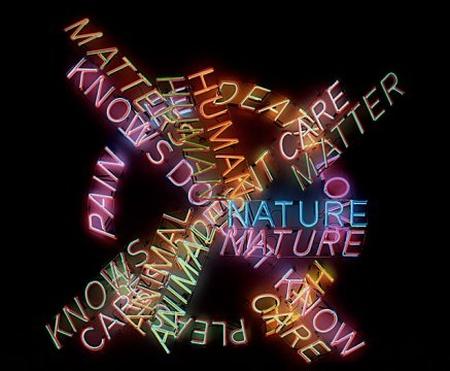
Human Nature/Life Death/Knows Doesn't Know
1983
Bruce Nauman
b. December 6, 1941
_______________________
Self-translation / Self-destruction
Ian Monk
words without borders
(....)
... And what good company I was now in—I thought at once of one of my all-time favorites, Samuel Beckett, and how he had continued to write in both English and French, before self-translating his work one way or the other, as required. It was a dream come true. I got down to work…
And what a pain it turned out to be. ...
(....)
... I happened upon an old interview with none other than Beckett himself, in which he rued that his desire for control had led to him taking a hand in the German versions of his writings, and how translating his own work into French or into English was a kind of torture, given that “the whole business of creation has already been done, and going through it all a second time over is extremely dull.” Here was the key to the puzzle. While translating someone else can be a fascinating form of “creation,” which entails grasping a text as closely as possible, then “making” another language “say the same thing,” the entire creative process has already been gone through in great depth when writing a given text for the first time. Recreating it in another language is thus not only tedious, but strangely “artificial,” and the result quite often abortive, while someone else could well have breathed new life into the piece and made it live again happily in its new linguistic world.
Years later, I still write in English and French. (Why one, then the other? Sorry, that’s quite another story.) And I still translate. But never, if it can be helped, myself.
...(more)
_______________________
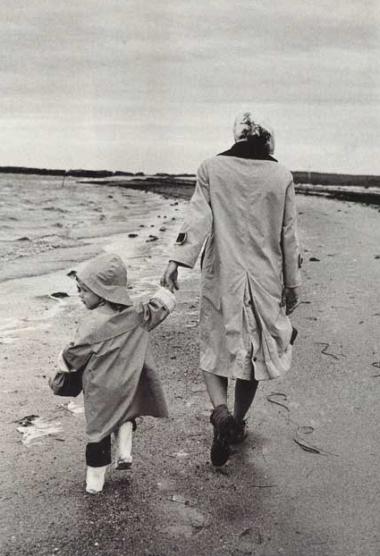
Alfred Eisenstaedt

portrait of Mother
1924
Aleksander Rodchenko
b. December 5, 1891
_______________________
Fear of the Inexplicable
Rainer Maria Rilke
b. December 4, 1875
But fear of the inexplicable has not alone impoverished
the existence of the individual; the relationship between
one human being and another has also been cramped by it,
as though it had been lifted out of the riverbed of
endless possibilities and set down in a fallow spot on the
bank, to which nothing happens. For it is not inertia alone
that is responsible for human relationships repeating
themselves from case to case, indescribably monotonous and
unrenewed: it is shyness before any sort of new,unforeseeable
experience with which one does not think oneself able to cope.
But only someone who is ready for everything, who excludes
nothing, not even the most enigmatical, will live the relation
to another as something alive and will himself draw exhaustively
from his own existence. For if we think of this existence of
the individual as a larger or smaller room, it appears evident
that most people learn to know only a corner of their room, a
place by the window, a strip of floor on which they walk up and
down. Thus they have a certain security. And yet that dangerous
insecurity is so much more human which drives the prisoners in
Poe's stories to feel out the shapes of their horrible dungeons
and not be strangers to the unspeakable terror of their abode.
We, however, are not prisoners. No traps or snares are set about
us, and there is nothing which should intimidate or worry us.
We are set down in life as in the element to which we best
correspond, and over and above this we have through thousands of
years of accommodation become so like this life, that when we
hold still we are, through a happy mimicry,scarcely to be
distinguished from all that surrounds us. We have no reason to
mistrust our world, for it is not against us. Has it terrors,
they are our terrors; has it abysses, those abuses belong to us;
are dangers at hand, we must try to love them. And if only we
arrange our life according to that principle which counsels us
that we must always hold to the difficult, then that which now
still seems to us the most alien will become what we most trust
and find most faithful. How should we be able to forget those
ancient myths about dragons that at the last moment turn into
princesses; perhaps all the dragons of our lives are princesses
who are only waiting to see us once beautiful and brave. Perhaps
everything terrible is in its deepest being something helpless
that wants help from us.
_______________________
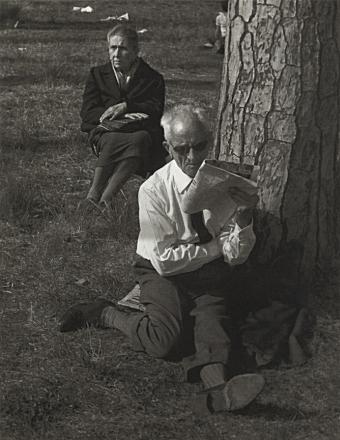 1950
Walter Rosenblum
(1919-2006)
.....................................................
Walter Rosenblum interview
Camera & Darkroom 1991
(....)
When I began in photography, Strand was my mentor and friend. I knew very little about printing, while Strand was a great master. One day, while I was helping him at the warehouse where he stored his photographs, he came across some old platinum prints. As I looked over his shoulder, he calmly proceeded to tear some of those prints into small pieces. Finally, I got up enough nerve to ask why. “Not good enough” was his reply.
It was a wonderful lesson for a young photographer. Tearing up a print over which you have labored intensively because it is not good enough means you are in control. When I go into the darkroom, I am establishing a rapport with a piece of film that must become my friend. That negative has many secrets that I need to explore. It is a lifeline between what I saw and what I can produce as a finished print.
...(more)
_______________________
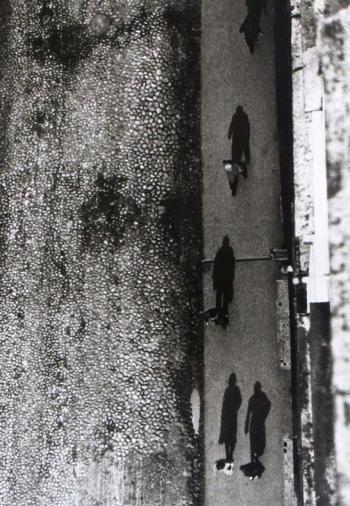
Alexander Rodchenko
_______________________
Making waves: Urban technology and the co–production of place
Laura Forlano
Abstract
Over the past several years, as cities in the United States have faced increasing fiscal pressures, there has been a reinvigorated interest in the promise of smart cities, intelligent cities, digital cities, open source cities and media cities, which advocate the use of digital technologies to make cities more efficient, productive, innovative and attractive. However, the appropriation and use of urban technologies have transformed the aesthetic, symbolic and lived experience of cities in important ways, which have not been well described or theorized. Based on theories from communications, science and technology studies as well as more specialized fields such as urban informatics, this article attempts to understand the ways in which urban technologies are appropriated and used to co–produce place relying on empirical examples from art and design, social science, and information and computer science. Finally, it illustrates the ways in which place is constituted at the intersection of socio–technical practices as dynamic, relational and interdependent.
_______________________
The Way We Live Now: Data Economy
The Occupied Times
_______________________
Corporations in Our Heads
Redeye: Vancouver Cooperative Radio
Theatre for Living's new show investigates how our psyches have been colonized by corporations from Lululemon to Enbridge and begins the process of transforming our relationship to that messaging. We caught up with artistic director David Diamond on tour in Langley. David Diamond speaks with Redeye host Lorraine Chisholm.
Redeye 100.5FM
_______________________
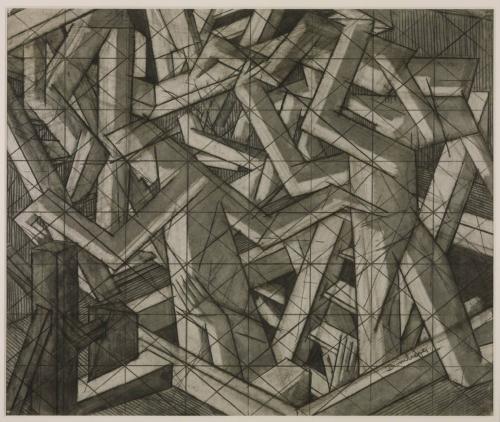
Study for 'In the Hold'
c.1914
David Bomberg
b. December 5, 1890
_______________________
People have already had to rethink so many concepts of motion; and they will also gradually come to realize that what we call fate does not come into us from the outside, but emerges from us. It is only because so many people have not absorbed and transformed their fates while they were living in them that they have not realized what was emerging from them; it was so alien to them that, in their confusion and fear, they thought it must have entered them at the very moment they became aware of it, for they swore they had never before found anything like that inside them. just as people for a long time had a wrong idea about the sun's motion, they are even now wrong about the motion of what is to come. The future stands still, dear Mr. Kappus, but we move in infinite space.
How could it not be difficult for us?
Rilke, Letters To A Young Poet - #8

photo - mw
_______________________
some free offerings at Open Humanities Press
Architecture in the Anthropocene:
Encounters Among Design, Deep Time, Science and Philosophy
edited by Etienne Turpin
New Materialism: Interviews & Cartographies
Rick Dolphijn and Iris van der Tuin
The Democracy of Objects
Levi R. Bryant
_______________________
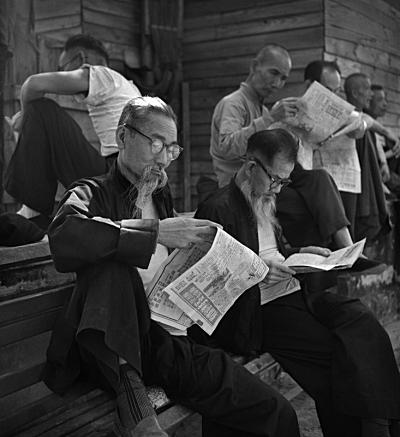
Fan Ho - Hong Kong Yesterday
Modernbook Gallery
Fan Ho, Hong Kong Master Street Photographer #1
(Leica Liker)
_______________________
Humanism for a globalised world
Ten years after his death, Edward Said’s work remains a guide for how to hold universal principles in increasingly diverse societies
Priyamvada Gopal –
(....)
While he was a fierce critic of empire, Said was profoundly interested in what could be done with a concept like humanism, laden as it is with the baggage of colonial civilisational missions and Eurocentrism, the worldview that assesses the rest of the world through the lens of European and white superiority. Perhaps surprisingly, at least for those who (despite his vocal protestations) read him as the originator of a postmodern and postcolonial approach to culture, Said describes himself as a humanist, insisting that “attacking the abuses of something is not the same thing as dismissing or entirely destroying that thing.” He himself remained unaffected by the antihumanism that characterised academic postmodernism with its “dismissive attitudes” to ideas such as enlightenment and emancipation. What then is the humanism that Said wishes to not have thrown out with the bathwater of discredited colonial or racist projects? For him, “the core of humanism is the secular notion that the historical world is made by men and women, and not by God and that it can be understood rationally ... Or to put it differently, we can really only know what we make.”
(....)
Said’s sense of the secular – he had long championed a style of thinking and scholarship that he termed “secular criticism” – is much more substantial than an insistence on compulsory atheism or a formal separation of church and state. Secularism for him has much more to do with being able to step outside the paradigms or ideologies to which one is habituated and then challenging not just others but oneself to question received ideas. At the heart of the practice of humanist secularism is a refusal to “denigrate, demonise, and dehumanise” or to “consolidate and affirm one tradition over another.” But Said was emphatically no relativist and had little time even for the more acceptable academic versions of relativism that underlay postmodern shibboleths like “indeterminacy”. The point he is making here is a nuanced one – that cultures and traditions are not, ultimately, neatly sealed off from each other and, just as none has a copyright on humanist values or ideas, none can be regarded as constitutively backward.
...(more)
_______________________
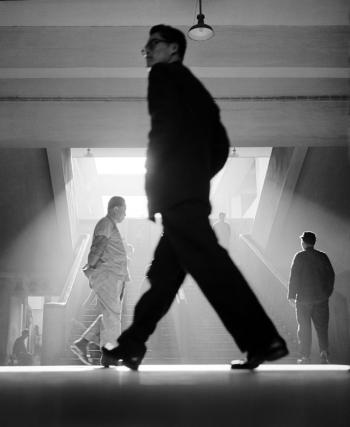
Fan Ho
_______________________
Interview with André Schiffrin
Gwenael Pouliquen, Jacques Testard
the white review
(....)
There are people – like François Maspero in France – who did a lot more than we did. Sadly, now, publishing is almost entirely a matter of profitability, meaning that if you want to publish something that is immediately profitable, it’s very rare that it will turn out to be predicated on strong ideas, or dissident ideas.
That’s a big problem. It has considerably reduced the amount of good books published, even though now there are small independent publishing houses who are publishing whatever they want to.
My German editor, who wrote a fantastic biography of Kafka, says that without a free publishing industry, there can be no democracy. And that is particularly the case in France, where most of the newspapers belong to people who manufacture weapons, and books are just about the only place where you can express ideas that are not mainstream.
...(more)
.....................................................
Reading about the death of publishing giant André Schiffrin , the longtime editor in chief at Pantheon Books who also founded the New Press, led me to reflect on the importance of books in my life. Without independent-minded publishers like Schiffrin, who was willing to lose money in order to publish books he deemed important, would I have become an academic? It’s a serious question.
Two of the books Schiffrin published at Pantheon were crucial to my early intellectual development: The Chomsky Reader (1987) and Noam Chomsky and Edward Herman’s Manufacturing Consent: The Political Economy of the Mass Media (1988). These books, and Noam Chomsky in general, taught me how to read texts through a critical lens, and how to recognize the biases of the politically powerful in even the most seemingly of objective expressions. Even though I have since come to different understandings of power and knowledge—even though, for example, I see the merits in Foucault, whom Chomsky famously debated in 1971 —Chomsky was my gateway drug to a hermeneutics of suspicion.
My guess is that Chomsky started many people down similar paths.
Andrew Hartman
The Society for U.S. Intellectual History
_______________________
Slaves to Contradictions: 13 Myths that Sustained Slavery
Wilson Ray Huhn
Social Science Research Network (SSRN)
Abstract:
People have a fundamental need to think of themselves as “good people.” To achieve this we tell each other stories – we create myths – about ourselves and our society. These myths may be true or they may be false. The more discordant a myth is with reality, the more difficult it is to convince people to embrace it. In such cases to sustain the illusion of truth it may be necessary to develop an entire mythology – an integrated web of mutually supporting stories.
This paper explores the system of myths that sustained the institution of slavery in the antebellum United States.
The New Nullification Movement
Some states are reviving disenfranchisement schemes that date back to the antebellum South.
Ari Berman
The long shadow of slavery
Omnivore
_______________________
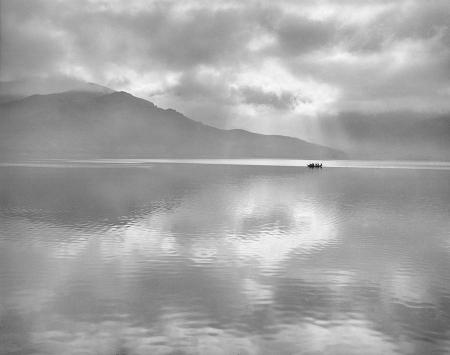
Shatin Morning
Fan Ho
_______________________
The Invention of Photography
W. S. Di Piero
threepenny review
(....)
*
In the fearless 1850s, mad-hatters forged
images of dolls, doilies, sewers,
eight-year-old odalisques
in off-the-shoulder nighties...
Gentleman Brits claimed their Sphinx
and Hindoo temples. We had our Civil War,
rail cuts and silver mines,
darkroom vans racked with plates,
jerky, mule feed, cameras
the Sioux called shadow catchers.
*
Pull the lens cover,
the ground glass blinks a century
to a two-minute wonderment,
when every decent family craved
its Polaroid and waited to see what
it would make of us, how inhale
blood matter and lick it into life.
*
...(more)
_______________________
Yesterday’s World: A Stefan Zweig Festshrift
Robert Birnbaum
ourmaninboston
Upon seeing Jonathan Franzen’s recent The Kraus Project(Farrar Giroux Straus)it occurred to me that perhaps the wrong fin-de siecle Viennese Jewish intellectual was being rescued from the aforementioned dustbin of history.
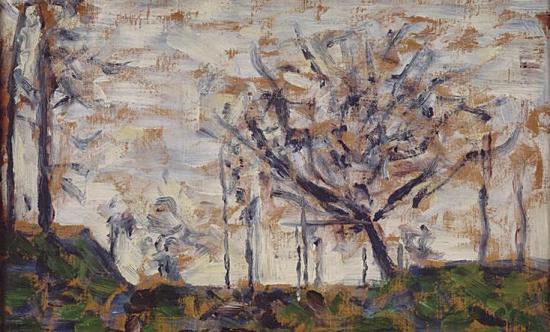
Trees, winter
1883
Georges Seurat
b. December 2, 1859
_______________________
Javier Téllez
interviewed by Pedro Reyes
bomb
Erasmus of Rotterdam claimed there were three types of people: those who lived in a dream world, those who lived in reality, and those who were able to turn one world into the other. The Venezuelan artist Javier Téllez belongs in this third category of people for whom the boundary between reality and unreality, reason and madness, is not only shadowy but also worth delving into. For the Scottish psychiatrist R. D. Laing such constructs do nothing but create artificial divisions whose function is to ensure the preservation of the status quo. If, in a similar vein, Téllez’s projects build a bridge between these two worlds, opening the possibility of creative collaborations with the so-called mentally ill, he avoids the pieties associated with art therapy by warning us that he seeks “not a therapeutic practice to cure the insane but rather one to cure the sane of their lucidity.”
Téllez and I once played telephone with tin cans perched on trees at the Utopia Station site for the 50th Venice Biennale, but, for the following interview, we discussed his increasingly depurated film projects—Oedipus Marshal (2006), Letter on the Blind for the Use of Those Who See (2007), and Caligari and the Sleepwalker (2008)—over the less cumbersome and more contemporary mediums of the telephone, email, and Skype.
...(more)
_______________________
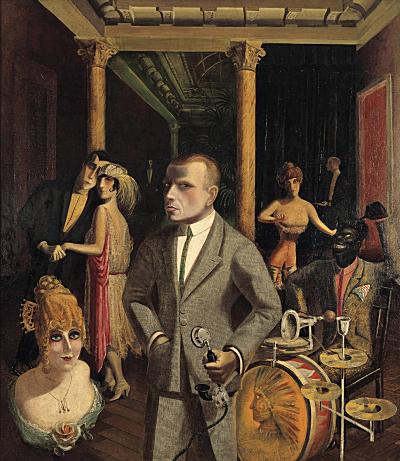
To Beauty
1922
Otto Dix
b. December 2, 1891
_______________________
Walmart and Downton Abbey:
rampant inequality and detachment from reality
Sadhbh Walshe
I'm not exactly sure what it is about the hit British TV series, Downton Abbey, that has enthralled so many of us. The scenery is great, Lady Mary's wardrobe is just fabulous, but there are plot holes so huge one could drive Lady Edith's car through them. I suspect the fascination it provokes has something to do with nostalgia – a hankering for a simpler time, when everyone knew their place and where the classes, though separate and unequal, were at least able to be polite to one other. Whatever it is that we find so charming about the series, however, we should try to keep in mind that the rampant inequality it celebrates is not something we should be hankering after.
...(more)
_______________________
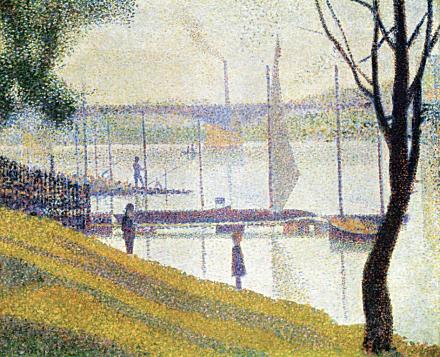
The Bridge at Courbevoie
1887
Georges Seurat
_______________________
Only in Things
W. S. Di Piero
Some days, who can stare at swathes of sky,
leafage and bad-complected whale-gray streets,
tailpipes and smokestacks orating sepia exhaust,
or the smaller enthusiasms of pistil and mailbox key,
and not weep for the world's darks on lights, lights on darks,
how its half-tones stay unchanged in their changings,
or how turning wheels and wind-trash and revolving doors
weave us into wakefulness or dump us into distraction?
This constant stream of qualia we feel in our stomachs.
The big-leafed plant lifts its wings to greet the planet's chemistry,
the sun arrives on rooftops like a gentle stranger, rain rushes us
love to love, stop to stop, these veins of leaf, hand,
storm and stream, as if in pursuit of us and what we are becoming. quoted in
Conversation: W. S. Di Piero, Winner of the 2012 Ruth Lilly Poetry Prize
W. S. Di Piero at the Poetry Foundation and Poetry International
_______________________
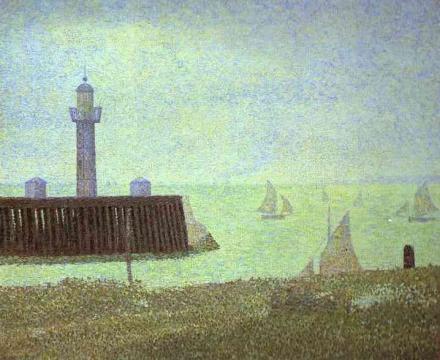
The End of a Jetty, Honfleur
1886
Georges Seurat
_______________________
Words without Borders December 2013: Oulipo
Words with Borders: Writing from the Oulipo
Daniel Levin Becker
As the prevailing image used by book reviewers to praise literary translations is that of transparency—limpid, pellucid, crystalline—it seems clear, so to speak, how ready we are to think of language as a window onto meaning. Whatever difficulties a translator may have encountered in carrying that meaning over into a new syntactic, lexical, and cultural idiom, we tend to expect his or her fingerprints to be wiped away by the time the text arrives before us, and for the resulting view to be more or less the same as the view enjoyed by the native reader. For better and occasionally for worse, we tend to be correct.
The Oulipo—ouvroir de littérature potentielle, or workshop for potential literature, a Paris-based literary collective dedicated to exploring how literature might arise from structures, rules, and constraints borrowed from linguistics or mathematics or parlor games—presents an uncommonly acute challenge to that expectation. To write an Oulipian text is both to draw a picture and to solve a puzzle, and more often than not these two missions blur together to the point where it becomes impossible to discern where the language ends and the meaning, such as it is, begins.
So, as you might imagine, things get doubly complex when a second language comes into play. Each language is a system unto itself, with its own rules and cheat codes, its own alliances and enmities and tunnels and trapdoors—and since exploiting all of these is the very essence of Oulipian methodology, since language is not only the raw material of an Oulipian experiment but also its demonstrandum, we might ask what, in this context, translational transparency even means. What happens when, to bedevil McLuhan, the window is the view?
...(more)
_______________________
E-Literary and the Social
Janez Strehovec
electronic book review
It often seems that autopoiesis and self-reference play a crucial role in the basic understanding of e-literature, which the established scholarship (e.g. e-literary criticism) considers first and foremost in terms of its new media specificity. This practice is distinctly contextualized and embedded in contemporary society and its paradigm shifts. In the present time, defined by capitalism, which does not leave anything outside of its influence, there is also no point in leaving the e-literary text outside, i.e. without any references to "the social" and to theories that deal with new social and cultural paradigms. The challenge of broader social theory application in this field is therefore the current topic of interest in this essay. To emphasize the specificity of an e-literary piece (as a performance, event, procedure, program, ride, textual instrument) directs us to its materiality, which is a very historical, changeable category. The requirements for full autonomy of this field as separated from the social (the claim of modernist aesthetics), have passed. Today we recognize that software is also a cultural and social tool (Galloway, 2012). In this essay, we are going to discuss some key theoretical notions on the issue of "the social" at the present time and their application in the field of e-literature.
...(more)
_______________________
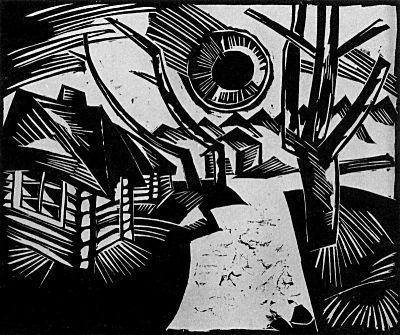
Woodcut
1919
Karl Schmidt-Rottluff
b. December 1, 1884
|
